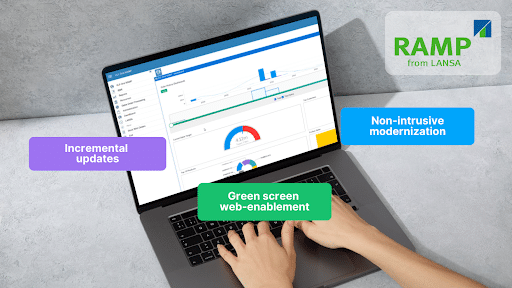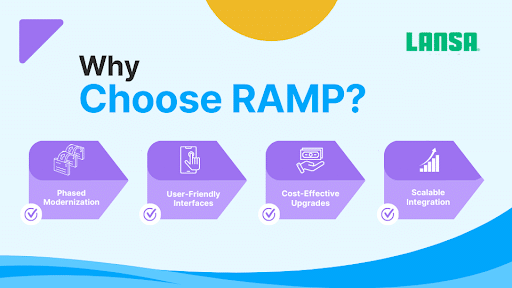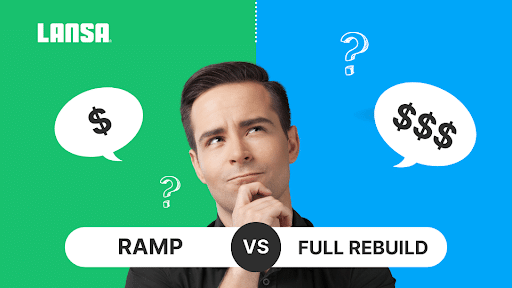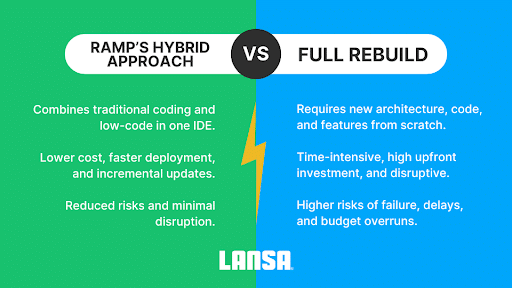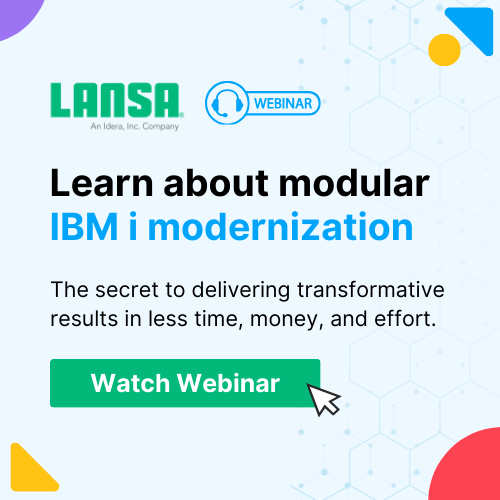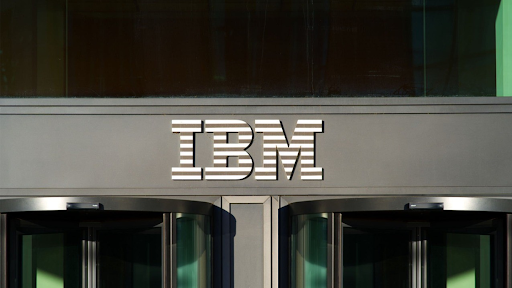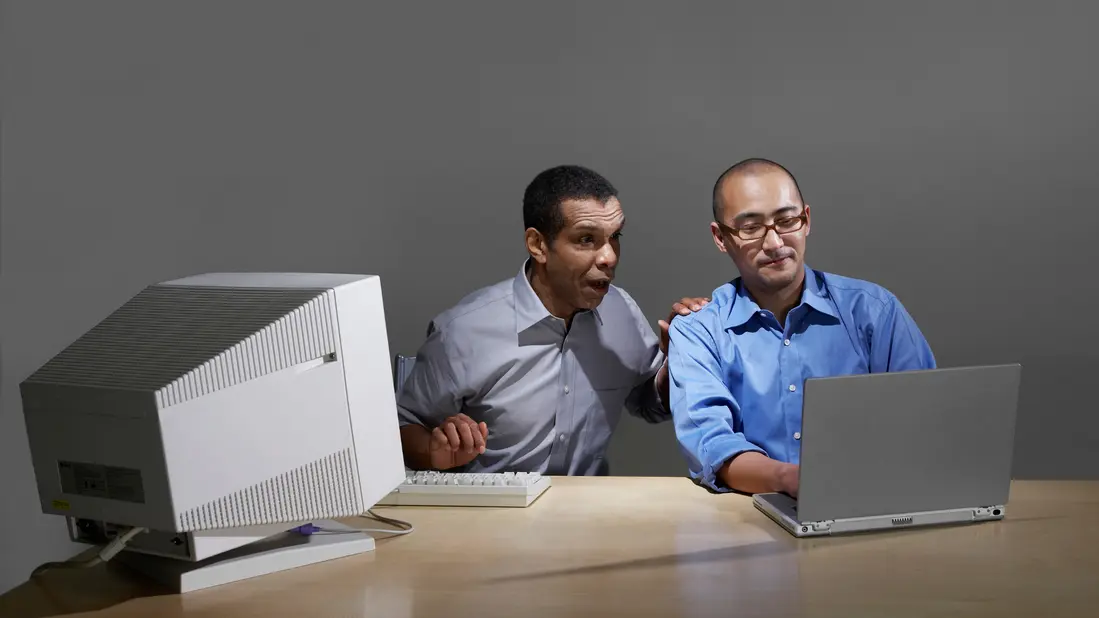IBM i applications have been a cornerstone of many industries, but with the rapidly evolving digital landscape, modernizing legacy IBM i applications has become a necessity. Updating these systems is essential for improving performance, adaptability, and overall business agility.
This is where RAMP steps in. RAMP (Rapid Application Modernization Process) by LANSA offers a seamless and flexible approach to bridge the gap between legacy IBM i systems and modern demands. It provides a structured path that reduces risk and cost, supporting both the transition from a green screen to a graphical user interface (GUI) and long-term 5250 modernization. By modernizing incrementally, RAMP guarantees minimal disruption while enhancing usability and scalability. With its composite application framework, RAMP enhances the user experience across devices like Windows, Linux, macOS, iPad, and Android tablets and enables gradual system evolution.
Key Insights
- RAMP (Rapid Application Modernization Process) is a powerful tool for modernizing your IBM i applications.
- RAMP employs a step-by-step modernization approach, ensuring minimal disruption to ongoing business operations. This allows companies to update their legacy IBM i applications without the need for a complete overhaul to ensure a smooth transition.
- RAMP’s hybrid method combines traditional coding with low code to reduce the risk of project delays and accelerate deployment. It supports continuous testing and validation to ensure updates align with business needs, speeding up modernization while minimizing errors.
- With RAMP’s modular framework, businesses can implement incremental updates, reducing initial costs and allowing strategic resource allocation for ongoing modernization.
Understanding RAMP
RAMP (Rapid Application Modernization Process) is a powerful framework designed to modernize 5250 applications by transforming them into a web-based interface and then building new features on top of it. Coupled with Visual LANSA, RAMP simplifies the modernization process by reusing existing logic and database structures to allow businesses to integrate new features seamlessly without overhauling the entire system. This will allow RAMP to optimize the usability and flexibility of the application to match modern standards and accelerate the change of legacy systems with minimal disruptions.
RAMP includes aXes lite, which web-enables green screen applications without coding. This capability alone greatly minimizes the time and effort to bring new developments to the surface while helping organizations to deploy upgraded systems rapidly. By implementing RAMP, organizations can react to the digital revolution by protracting the life cycle of inefficient applications and enhancing user experience.
RAMP not only drives modernization but also preserves older systems from becoming obsolete. It enhances IBM i applications with new Web 2.0-like modules, providing a flexible solution that adapts to evolving business needs. It offers flexibility and long-term value, helping companies stay competitive and cost-effective in their modernization efforts.
Why Choose RAMP?
Summary of RAMP’s key benefits
RAMP stands out as a comprehensive solution for modernizing legacy systems; it provides a phased approach that minimizes risks and ensures smooth transitions. Its user-centric design enhances usability and productivity, while cost-effective updates and seamless integration capabilities enable businesses to adapt to evolving needs without significant disruption.
By combining flexibility, scalability, and innovation, RAMP empowers organizations to streamline processes, future-proof operations, and achieve sustainable growth. Discover why RAMP is the best choice for organizations to drive efficiency and position their business for long-term success.
Phased Modernization for Minimal Disruption
RAMP helps implement a phased modernization strategy that doesn’t disrupt day-to-day business operations. With RAMP’s modular approach, businesses can modernize their applications incrementally instead of requiring a complete overhaul. This allows organizations to preserve the core functionality of the existing systems while updating the user interface and integrating new features.
For example, PartyLite implemented RAMP to gradually modernize its customer service ERP module, helping the company integrate multiple separate programs into a single application with easy-to-navigate tabs. This streamlined interface allowed customer service representatives to access the tools quickly and efficiently, improving the productivity of their call center.
By adopting this phased approach, PartyLite avoided major operational disruptions while achieving a smoother, more efficient modernization process.
User-Friendly Interfaces for Enhanced Usability
With RAMP, businesses can transform outdated green screen applications into modern and intuitive user web-based interfaces. This enhances the user experience by replacing the text-based complex navigation with visually appealing and easy-to-use layouts. These user-friendly interfaces boost employees’ productivity while reducing the learning curve for new users.
For instance, PartyLite leveraged RAMP’s ability to upgrade its old interfaces to contemporary, user-friendly UIs. This included modernizing aspects like sorting and searching products, consultants, and orders with integrated web access for tracking parcels to improve the customer service representative’s overall usability. Additionally, RAMP introduced integrated web access, enabling customer service representatives to track parcels seamlessly. By updating its interfaces, PartyLite modernized not only its technology but also the way its team interacted with vital business applications.
Cost-Effective Incremental Upgrades
RAMP supports modular upgrades to allow businesses to modernize selectively and manage resources effectively. With RAMP, businesses can modernize the critical components with immediate effect first and gradually modernize other areas as needed. By reusing existing logic and database structures, RAMP minimizes redevelopment expenses while maximizing the value of legacy systems. This approach offers a cost-effective and practical modernization process without draining resources.
Scalable Feature Expansion for Future-Ready Systems
RAMP’s modular framework supports the integration of new functionalities into existing systems for scalability and future growth. This flexibility was key for PartyLite, which utilized RAMP to provide a customized AS/400 ERP solution. The changeover helped simplify operations by eliminating disparate external systems in favor of a unified and real-time interface. Also, RAMP’s adaptable structure made it easy to facilitate complex inventory forecasting and analysis tools, which means that PartyLite can efficiently administer complicated database queries as well as big volumes of data. Because of the flexible design of RAMP, PartyLite’s systems could continuously adapt and expand based on the changing needs of the business. This future-ready foundation empowered PartyLite to innovate continuously while maintaining stability and efficiency across its operations.
RAMP vs. Full Rebuild
A man thinking of RAMP vs. Full Rebuild in application development
Modernizing legacy systems often presents businesses with a critical decision: whether to choose a complete system rebuild or leverage RAMP’s hybrid approach. Here’s how these approaches stack up:
Complete System Rebuild Vs. RAMP’s Hybrid Approach
A Comparative Illustration of RAMP vs. Full Rebuild
When it comes to a complete system rebuild, companies need to create an entirely new architecture and user interface, starting from scratch with writing code, implementing features, and system construction. This process demands significant time, large financial investment, and more effort at each stage of development. In addition, it has higher risks of potential project delays, budget overruns, and the possibility of failing to meet all business requirements.
On the other hand, RAMP offers a hybrid approach that combines traditional coding with low-code development in a unified, integrated development environment(IDE). By enabling incremental updates, RAMP allows enterprises to continuously test and validate new features, ensuring that any issues are addressed early in the process. Furthermore, RAMP’s phased deployment approach enables faster rollouts with minimal disruption to ongoing operations, making it a more cost-effective, less risky, and faster-to-deploy solution.
RAMP’s Phased Modernization for IBM i Systems
RAMP (Rapid Application Modernization Process) provides a streamlined solution to bridge the gap between legacy IBM i systems and modern demands. Its flexible and structured approach to modernizing IBM i systems ensures a smooth transition while minimizing disruption, making it a cost-effective and efficient way to future-proof your IBM i systems.
By employing a hybrid approach, RAMP minimizes large upfront investments, enabling incremental updates that allow for continuous testing, faster deployment, and reduced risks. This ensures your IBM i systems remain reliable, scalable, and aligned with your organization’s evolving needs.
Getting Started with RAMP
Are you ready to modernize your applications, and introduce new functionalities and a friendlier user interface without writing extensive code?
Significantly reduce development time with RAMP. Contact us today to discuss your modernization project with our experts.


